NEW Les survivantes: Offener Tourenwagen authentique Hitler (IA-148697) du Musée Canadien de la Guerre (Français-English)
Cette voiture a été l'une de celles utilisées par Adolf Hitler. Elle est depuis 1970, exposée au Canadian War Museum d'Ottawa. Mais à l'origine et pendant longtemps, la légende voulait qu'elle ait été la 770 d'Hermann Goering. C'était sans compter sur la perspicacité d'un bibliothécaire du Musée. Voici cette longue histoire...
Le 8 juillet 1940, la Chancellerie du reich reçoit une nouvelle 770 de type w150 II, c'est à dire blindée, commandée à Daimler-Benz le 3 novembre 1939 C'est sur l'insistance particulière de son chauffeur, Erich Kempka, que Hitler jusque là totalement opposé à cette idée, s'est finalement résolu à accepter un véhicule blindé. L'attentat du 8 novembre 1939 à la Bürgerbräukeller de Munich n'est sans doute pas étranger à ce revirement.
La voiture effectue ses premiers tours de roue le 19 juillet 1940, lorsque le Führer se rend à l'Opéra Kroll qui depuis l'incendie du Reichstag en 1933, abrite cette assemblée. L'objet de ce déplacement est de récompenser, au cours d'une cérémonie grandiose, les généraux victorieux contre la France et les Pays-Bas en les élevant à la dignité de maréchaux. Les actualités cinématographiques allemandes sont là. On voit la IA-148697 quitter la Chancellerie, parcourir la Potzdamer Platz avant d'arriver au Kroll Oper situé fâce à l'ancien Reichstag
Du 29 mars au 4 avril 1941, le Ministre des Affaires étrangères japonais, Yōsuke MATSUOKA, est en visite à Berlin. C'est à bord de la IA-148697 qu'il quitte en compagnie de son homologue Ribbentrop, l'Anhalter Banhof (la gare centrale de Berlin) pour gagner le Chateau Bellevue, qui depuis 1938 est la résidence officielle des hôtes de l'Allemagne.
Une longue séquence de "Die Deutsche Wochenschau" N° 552-15-1941 nous dévoile nombre d'aspects de cette magnifique voiture...
Cette voiture est parvenue jusqu'à nous. Elle est exposée au Musée canadien de la guerre à Ottawa. Mais elle a aussi une histoire qui commence en 1945 lorsqu'elle est saisie par l'armée américaine et que par suite d'un quiproquo, elle est considéré non comme étant la voiture du Führer mais simplement celle de Goering.
La revue "After the Battle" commettra même en 1974, un article totalement erroné en présentant trois 770 différentes!
Le mythe va se perpétuer longtemps...jusqu'en 1982 et la parution d'un article rédigé par Ludwig Kosche dans la revue "After de Battle". qui a révélé de façon concluante que la voiture était bien celle de Hitler. L'étude de Kosche est complete, méticuleuse, et indiscutable. Il n'est qu'a voir l'impressionnante documentation qu'il avait réuni et qui représente plus de trois mètres de linéaires dans les archives du Musée. Le fruit des recherches de Ludwig Kosche est accessible ici : http://www.warmuseum.ca/wp-content/uploads/2015/10/ludwigkosche_f.pdf (en français) et http://www.warmuseum.ca/wp-content/uploads/2015/10/ludwigkosche_e.pdf en anglais.
Ci-dessous, l'article de Kosche paru dans "After the Battle", n°35 - 1982
Ludwig Kosche (1929-2000), né à Brème en Allemagne, était le bibliothécaire du Musée Canadien de la Guerre de 1973 à 1985; Dès l'arrivée de la voiture, il se passionna pour son histoire et mena des recherches à titre privé. Il publia nombre d'articles à ce sujet et projeta un moment d'écrire un livre.
Mais revenons en mai 1945...
Le sergent T. Joe Azara de la 20th Armored Division (20e Division blindée) avait trouvé la voiture stationnée sur un wagon-plateau dans une voie de chemin de fer à Laufen, un village situé au nord de Salzbourg, en Autriche. Après un bref échange de feu avec des tireurs d'élite allemands, Azara s'empara du véhicule dont il dû remplacer rapidement le moteur d'origine par un autre de même puissance retiré d'une autre Mercedes trouvée pour sa part dans les garages du Berghof, à Berchtesgaden, situé juste au nord de Laufen près la frontière austro-bavaroise;
Presqu'aussitôt, la 770 va être associée à Goering. Et à la lecture du journal de la 20e division blindée,The Dispatch, Kosche attribue cette association à une déclaration faite à l'époque par un prisonnier néerlandais près du lieu où la voiture avait été capturé. Il avait indiqué que la voiture avait été envoyée depuis Berstechgaden parce qu'elle était en panne et que Goering n'en voulait plus!
Expédiée aux Etats Unis au mois d'août 1945 et enregistrée comme étant la voiture du Maréchal, la 770 demeurera près de neuf ans dans les garages du Bureau d'aliénation des biens de l'armée américaine (Property Disposal Office of the American military).
HJ O'Connell, un collectionneur de Montréal, en fait l'acquisition lors d'une vente aux enchères organisée par l'American Army's Aberdeen Proving Ground dans le Maryland en Novembre 1956 pour 2725 USD.
Intervient alors un nouveau quiproquo. O'Connel avait confié à R. J. Rumble de Rumble Motors à Toronto, le soin d'enchérir pour son compte. Mais lors de la même vente, une autre voiture était proposée. Il s'agissait d'une Mercedes 540k de 1943 affublée du sobriquet de «Blue Goose», et qui, c'est prouvé, avait en effet appartenu à Goering. La 540k pour sa part, avait été saisie par le 101st Airborne et en même temps qu'une autre 770 carossée en Offener Tourenwagen elle aussi. RJ Rumble supposa évidemment que la voiture qu'il venait d'acquérir pour O'Connel était l'autre Mercedes connu pour avoir été capturé par la 101st Airborne
Les voitures saisies par le 101st Airborne ( la 770 n'est pas celle du musée)
Rumble fût chargé de la restauration car la voiture avait beaucoup souffert depuis sa capture. Des balles avaient percé la plaque de blindage à l'arrière ainsi que le tableau de bord En outre, il y avait des impacts dans le pare-brise et il était fissuré.de même que la vitre avant droite. On a longtemps cru que ce dommage avait été infligé après la guerre par l'Aberdeen Proving Ground pour tester l'efficacité du blindage. Mais Kosche a montré de façon concluante, encore une fois en lisant The Dispatch, que ces dégâts avaient été déjà constaté au moment de la capture du véhicule en mai 1945, ce qui est totalement cohérent quand on sait que la voiture était stationnée dans qui était clairement une zone de combat.
Cette thèse est accréditée par les travaux de Leslie Redman le conservateur du Musée, en 1996. Les dégâts observés sur l'intérieur de la voiture et sa structure laissant à penser que la voiture avait été touchée par un projectile de forte puissance ne pouvant provenir que d'un avion.
La restauration de Rumble s'effectua sur la base d'une photographie d'une 770 de même type (probablement celle actuellement exposée à Rochetaillée). L'on sait depuis que c'est une erreur et la 770 de O'Connel se trouva ainsi affublée à tort d'une barre centrale porte phare devant le radiateur. O'Connel avait exigé que tout soit restauré à son état d' origine , à l'exception des vitrages brisés, car il souhaitait ainsi préserver l'authenticité du contexte de guerre.
Au terme d'une restauration qui coûta 5000 dollars canadiens, la 770 retrouva sa splendide laque noire originelle, non sans que Rumble ait observé que pas moins de dix huit couches de peintures recouvraient la carrosserie dans des harmonies allant du noir jusqu'à un vert (en fait gris) qu'il qualifia de Luftwaffe. Ce qui constitua encore un indice pour attribuer cette voiture à Goering. En fait les deux dernières couches étaient d'origine américaine et Kosche reçut le témoignage d'un ancien chauffeur de la Chancellerie (probablement Kempka) qui lui confirma que ce type de voiture n'allaient pas sur les théatres d'opérations et n'avaient pas reçu de peinture de camouflage avant que l'armée américaine ne s'y emploie.
Quelques années plus tard, la voiture devint la propriété de Claude Pratte, un industriel québécois. En octobre 1969, ce dernier souhaitant se libérer d'une dette envers les services fiscaux canadiens annonça son intention de céder la voiture au Musee en échange d'un quitus fiscal. Le conservateur, Lee Muray, écrit alors à son supérieur en ces termes " Un habitant de la ville de Québec, a offert de mettre à notre disposition, soit par prêt ou par don, la voiture du personnel du maréchal Goering. Il s'agit d'un élément historique très précieux, et son acquisition serait très opportune".
Pour autant, il y eut quelques réticences à accepter ce don au regard des maigres preuves d'association à un dignitaire du Reich, qui ne reposaient que sur des affirmations. Le musée tenta donc d'obtenir des informations plus précises. Il est curieux de constater que dès le départ, le Musée chercha un moyen d'établir le lien entre la voiture et Hitler.
Dans une lettre à Rumble en date du 14 novembre 1969, Lee Murray indique " En collaboration avec le propriétaire de la voiture censée avoir appartenu à Adolf Hitler, nous tentons de reconstituer l'histoire de la voiture et d'évaluer sa valeur , à la fois présente mais également en tant que voiture ancienne et relique de la seconde guerre mondiale". Il y a de quoi être surpris qu'aucune allusion à Goering ne soit faite. De même dans un autre courrier à l'attention d'un expert, E. A. Jurist, President de Vintage Car Store de New York, Murray écrit "Il s'agit de l'une des sept voitures livrée à l'armée allemande en 1940, et que nous reconnaisons comme des voitures utilisées par le Führer lors de ses apparitions publiques" Cette lettre se bornait à évoquer qu'elle aurait été attribué au maréchal Goering."
Rumble tenta alors de faire diversion en répétant la mythologie reçue: « Il y avait sept de ces unités achetées en 1940 par le quartier général de l'armée allemande et cette voiture particulière a ensuite été délivré à Goering, pas Adolf Hitler comme indiqué dans le premier paragraphe de votre lettre. Ces faits ont été corroborés par le numéro de série, etc"...
Rumble fournit alors un élément d'information essentiel qui jusque là avait été omis : le numéro de série de la voiture 429334 figurant avec les autres données techniques sur une plaque fixée sur la cloison pare-feu de la voiture.
Muni de cette précieuse information, Murray s'adressa à la Daimler-Benz à Stuttgart en espérant recevoir des informations plus détaillées sur l'histoire de la voiture. Cette demande demeura sans réponse et Murray n'eut d'autre ressource que de solliciter l'ambassadeur d' Allemagne à Ottawa, le Dr JF Ritter " Le Musée est extrêmement intéressé par une Mercedes Benz Type 770 voiture qui est au Canada. Elle est l'une des sept de ces magnifiques voitures qui ont été achetés par le siège de l' armée allemande en 1940. Celle qui nous intéresse porte le numéro de série 429334 et porte l'immatriculation 1Av148697. La légende veut que cette voiture ait été affectée au Maréchal Goering".
Dans l'intervalle, de nombreux autres doutes s'exprimèrent quant à l'appartenance présumée de la voiture à Hermann Goering. Ainsi, le 17 Février, lors de la remise de son évaluation, Jurist indiqua "qu'il est plus que douteux que chaque hauts dignitaires du reich se soit vu attribuer une 770 à titre personnel. par contre l'on sait que plusieurs 770 étaient destinées à l'usage exclusif du Führer"
Le 15 mai 1970 la voiture devenait la propriété du Musée et c'est en septembre qu'elle y arriva. Entretemps, et à la requête de Jean Drapeau, Maire de Montréal, elle fût présentée en tant que "voiture de Hitler" lors de l'exposition "Terre des Hommes" (en anglais "Man and his World") qui s'était poursuivie trois ans après l'Exposition universelle. Pour autant, au Musée, l'association avec Goering continua à persister au point de faire figurer une fausse plaque d'immatriculation sur la voiture, WL-148697 (WL pour Luftwaffe). Cette incongruïté allant jusqu'à faire figurer ce numéro à l'arrière en masquant l'immatriculation d'origine!
En septembre 1971, le Musée reçut une lettre d'un résident d'Ottawa Collett Calverley, jetant plus de doute sur l'association de la voiture avec Goering. Calverley avait écrit expressément "pour contester la croyance selon laquelle le véhicule a été utilisé par le Reichsmarschall Hermann Goering." Il attirait l'attention sur le fait que les Britanniques avaient déjà une Mercedes, capturé à Bad Homburg en 1945 et censée avoir été celle de Goering.Il précisait que ue la voiture britannique avait trois charnières de porte, alors que celle du Musée seulement deux, ce qui signifiait qu'elle était moins lourdement blindée. Fût il un personnage important peut on imaginer que la voiture du maréchal soit plus protectrice que celle destinée à Hitler?
S'ensuivirent une période de flottement intense au sein du Musée. Il semble que l'on était tout prêt de la vérité mais que l'on ne souhaitait pas modifier le message porté jusque là, sous peine de perdre en crédibilité.
En Novembre 1979 la voiture fût déplacé du troisième étage du MCG vers une autre gallerie. Victor Suthren, alors chef des expositions du musée, a noté dans un mémorandum à l' historien du musée Bernard Pothier "il semble que nous ayons besoin d'une nouvelle présentation" et a demandé Pothier de l' entreprendre. Une fois terminé, celle-ci contenait aucune référence à Goering ce qui reflète probablement les doutes croissants du personnel du Musée. La voiture était présentée en tant que "German Staff Car, 1940-1945" et même s'il n'était nullement fait référence au Reichsmarschall, la nouvelle légende continuait à évoquer les dix-huit couches alternées de vert Luftwaffe et de noir, justifiée par "une utilisation alternative sur les théatres d'opérations et les obligations officielles". Et sa capture était toujours attribuée à la 101st Airborne...
La polémique interne perdura. Le conservateur du CWM, Ralph Manning, suggéra que l'on aurait pu évoquer le fait que la voiture était susceptible d'avoir été utilisée par Hitler dans la meure où l'on sait qu'il disposait d'au moins six ou sept modèle du même type. Et à une note de Lee Murray l'interrogeant l'absence de toute référence à Goering Manning ajouta: "Nous avons été incapables de trouver un iota de preuve que notre voiture avait une relation particulière avec le Maréchal. Je pense même que nous devrions laisser tomber la référence dans toute légende".
C'est à ce moment qu'intervient Ludwig Kosche et son action va être déterminante.
Dans sa démarche, Kosche va été aidé de façon importante par une action antérieure du MCG. La couche de peinture qui avait été appliquée à la plaque d'immatriculation d'origine de la voiture à l'arrière a été retiré pour révéler l'identifiant original IAv148697. (en fait, le nombre avait été seulement obscurci den 1971, et le MCG était donc bien au courant avant). Avec l'immatriculation originelle et les plaques constructeur sous le capot, Kosche disposait d'élements primordiaux pour prouver que la voiture était bien celle de Hitler.
D'autre part, les recherches portant sur l'immatriculation révèlérent que le petit v rouge intercalé entre le IA signifiant Berlin et le numéro d'ordre 148697 avait été rendu obligatoire peu après le déclenchement de la guerre en Septembre 1939 et pour tous les véhicules sans lien avec l'armée, la police et le service postal. Celà démontrait que la voiture n'avait pu être utilisé par les militaires, et donc par la Luftwaffe. Enfin Kosche fit observer que la quasi-totalité des voitures utilisées personnellement par Hitler commençait par 148 XXX.
Kosche rassembla également une importante iconographie montrant Hitler dans la voiture. L'une des photos, prise onze jours après l'arrivée de la voiture à la Chancellerie, montre le Führer se rendant à l'Opéra Kroll (qui abrite le Reichstag). Tous les détails physiques de cette voiture sont similaires à celle du Musée de, sauf certains petits détails qui ont pu faire l'objet de modifications ultérieures) comme les phares occultés et le cerclage de métal autour des roues de secours De même l'immatriculation IAv148697 est clairement visible. Hitler est également photographié à son bord le 10 Septembre 1941 au cours une visite à Marienbad où il rencontre l'amiral Horthy, le 28 Novembre 1941, quand il assiste à l'enterrement de Werner Mölders; et le 15 Mars 1942 , quand il arrive au Zeughaus de Berlin pour un discours. C'est d'ailleurs la dernière apparition connue de Hitler et de la voiture.
La voiture a un certain nombre de caractéristiques qui, selon Kosche, "ne sont pas présentes sur d'autres photographies montrant des Grosser Mercedes 770 W150." quatre buses de désembuage/dégivragesous le pare-brise, portes soutenues par deux charnières courtes, vingt fentes de refroidissement sur les deux côtés du capot" Autant de signes distinctifs pour permettre à Kosche d'affirmer qu'il s'agissait de l'une des 770 d'Hitler,
En 1945, Azara n'a utilisé la voiture que très brièvement avant qu'elle ne soit remise à l'un des officiers supérieurs de la 20e division blindée, le général de brigade Cornelius Daly. Pour le service de ce dernier, il a été peint vert olive et doté d'un marquage sous forme d'étoile blanche (signe distinctif des véhicules utilisés par les armées alliées). Il est intéressant de noter que des travaux récents de conservation ont révélé via une photo infra-rouge, le «schéma à peine visible d'une étoile" dans le centre du toit en tissu. L'ensemble de ces marques étaient présentes lorsque la voiture a été convoyée vers les Etats-Unis.
D'autres photo démontrent bien que la voiture capturée par Azara est bien la même aujourd'hui au musée. A l'issue de son arrivée à Boston le 8 Août 1945, plusieurs photos parurent dans la presse (Daily Globe de Boston "Goering's Auto Bullet Proof to protect Fat Marshal's Hide" Le journal a publié quelques illustrations de la voiture, dont l'une, montrant le tableau de bord et le pare-brise. Ces mêmes photos se retrouvèrent dans Newsweek du 20 Août 1945). Il est clair que les dommages photographiés à l'époque correspondent exactement à ceux présents aujourd'hui. En outre, le compteur kilométrique cassé de la voiture à son arrivée aux États-Unis était bloqué sur 13 900 km, tout comme la voiture du Musée.
L'article de Kosche a répondu à la plupart des questions historiques sur la voiture, et identifié formellement la voiture comme celle d'Hitler. Toutefois à partir de la publication en Février 1982, il fallut attendre Avril 1984, pour que les informations à destination du public soient rectifiées en ces termes "des preuves photographiques démontrent que Adolf Hitler a fait usage de cette voiture au moins jusqu'en 1942". Enfin, l'on a également mis à jour la partie qui attribuait à tort la capture à la 101st Airborne en lieu et place de la 20ème division blindée.
Une fois cette phase d'identification terminée, il a été nécessaire de procéder à l'aménagement d'un espace d'exposition approprié en relation avec l'importance accrue de ce vestige de l' Histoire. Son ouverture, en Septembre 1986 fit l'objet d'un communiqué de presse du MCG précisant "qu'à l'origine attribuée à Hermann Goering, la voiture a pu être formellement identifié comme voiture de service personnelle d'Adolf Hitler ..."
En plaçant la voiture dans un décor de carte postale bavaroise et de rappels de la période nazie, l'idée, louable, était d'informer le public sur le contexte ayant conduit au déclenchement du 2ème conflit mondial. Mais, cette démarche fût perçue comme une façon de magnifier la période nazie à la manière de Léni Riefenstahl. Le Musée sut répondre à ces critiques en ajoutant en toile de fond un rappel de pires atrocités du nazisme.
Enfin, en 2000, la voiture connût indirectement une autre péripétie quand l'idée de vendre la voiture aux enchères fit surface. Fort heureusement, il n'en fût rien.
--------------------------------------------------------------------------------------------------------------------------------
This car was the one used by Adolf Hitler. It is since 1970, exhibited at the Canadian War Museum in Ottawa. But originally and for a long time wanted to legend she was the 770 Hermann Goering. Did not count on the insight of a librarian Museum. Here is a long story ...On 8 July 1940 the Reich Chancellery receives a new 770 W150 type II, ie shielded, controlled Daimler-Benz 3 November 1939 This is the particular insistence of his driver, Erich Kempka that Hitler until then totally opposed to this idea, finally resolved to accept an armored vehicle. The bombing of November 8, 1939 in Munich Bürgerbräukeller is probably no stranger to this turnaround.
The car makes its first laps July 19, 1940, when the Führer went to the Kroll Opera House that since the Reichstag fire in 1933, is home to this meeting. The purpose of this move is to reward, at a grand ceremony, the general victorious against France and the Netherlands, raising the dignity of marshals. The German newsreels are there. We see the IA-148697 leave the Chancellery, the Potsdamer Platz go before reaching the Kroll Oper located just in front of the old Reichstag
From 29 March to 4 April 1941, the Japanese Minister of Foreign Affairs, Yōsuke Matsuoka, is visiting Berlin. It was aboard IA-148697 he leaves with his counterpart Joachim von Ribbentrop, the Anhalter Bahnhof (Berlin Central Station) to win the Chateau Bellevue, which since 1938 is the official residence of the hosts of the Germany.
A long sequence of "Die Deutsche Wochenschau" No. 552-15-1941 reveals many aspects of this beautiful car ...
This car has come down to us. It is exposed to the Canadian War Museum in Ottawa. But it also has a history that began in 1945 when seized by the US military and that as a result of a misunderstanding, it is not considered as the car of the Führer but simply that of Goering.
The myth is perpetuated long ... until 1982 and the publication of an article by Ludwig Kosche in the journal "After Battle". which showed conclusively that the car was that of Hitler. The study Kosche is full, meticulous and indisputable. It has not see the impressive documentation he had gathered and which is more than three meters of shelves in the archives of the Museum. The result of research of Ludwig Kosche is available here: http://www.warmuseum.ca/wp-content/uploads/2015/10/ludwigkosche_f.pdf (in French) and http://www.warmuseum.ca/wp -content / uploads / 2015/10 / ludwigkosche_e.pdf English.
Below Kosche article appeared in "After the Battle", No. 35-1982
Ludwig Kosche (1929-2000), born in Bremen in Germany, was the librarian of the Canadian Museum of War of 1973 to 1985; Upon arrival of the car, he was fascinated by its history and conducted research privately. He published many articles about it and threw a moment to write a book.
But back in May 1945 ...
Sergeant Joe T. Azara of the 20th Armored Division (20th Armoured Division) had found the car parked on a tray in a car track railway in Laufen, a village north of Salzburg, Austria. After a brief exchange of fire with German snipers, Azara seized the vehicle he had quickly replaced the original engine with another of the same power removed from another Mercedes for its part found in the garages Berghof in Berchtesgaden, just north of Laufen near the Austrian-Bavarian border;
Almost immediately, the 770 will be associated with Goering. And reading the newspaper of the 20th Armored Division, The Dispatch, Kosche attributed this association to a statement made at the time by a Dutch prisoner near where the car had been captured. He said the car had been sent from Berstechgaden because it was broken and that Goering wanted to do more!
Shipped to the United States in August 1945 and recorded as the car of Marshal, the 770 will remain nearly nine years in the garages of alienation Office of the US military property (Property Disposal Office of the American military) .
HJ O'Connell, a collector from Montreal, acquired it at an auction organized by the American Army's Aberdeen Proving Ground in Maryland in November 1956 for 2725 USD.
Then comes a new misunderstanding. O'Connell had told RJ Rumble Rumble Motors in Toronto, care to bid on his behalf. But at the same sale, another car was proposed. It was a Mercedes 540k 1943 decked the nickname "Blue Goose" and who is proved, had indeed belonged to Goering. The 540k for his part, had been seized by the 101st Airborne and yet another 770 carossée in Offener Tourenwagen too. RJ Rumble obviously assumed that the car he had just bought for the other Mercedes O'Connell was known to have been captured by the 101st Airborne.
Rumble was responsible for the restoration because the car had suffered greatly since his capture. Bullets had pierced the armor plate on the back and the dashboard In addition, there were impacts in the windshield and was fissuré.de same as the right front window. It was long believed that this damage had been inflicted after the war by the Aberdeen Proving Ground for testing the effectiveness of the shield. But Kosche has conclusively shown, again by reading The Dispatch, that the damage had already been found at the time of capture of the vehicle in May 1945, which is completely consistent when we know that the car was parked in was clearly a combat zone.
This thesis is accredited by the work of Leslie Redman curator of the Museum in 1996. The damage observed on the interior of the car and its structure suggesting that the car was hit by a high-powered projectile that can come from an aircraft.
The Rumble restoration was carried out on the basis of a photograph of a 770 of the same type (probably the one currently on display in Rochetaillée). We know that since it is a mistake and 770 O'Connell was thus wrongly decked with a central bar door leading to the radiator. O'Connell had demanded that everything be restored to its original condition, with the exception of broken glass, and because he wanted to preserve the authenticity of the context of war.
After a restoration that cost 5,000 Canadian dollars, the 770 regained its splendid original black lacquer, not without Rumble was observed that up to eighteen layers of paint covered the body in harmony from black to green (actually gray) he called Luftwaffe. This still constituted an index to assign this car to Goering. In fact the last two layers were of American origin and Kosche received the testimony of a former driver of the Chancellery (probably Kempka) who confirmed that this type of car did not go in operational theaters and had not received camouflage paint before the US military does not use it.
A few years later, the car became the property of Claude Pratte, a Quebec industrial. In October 1969, the latter wishing to free themselves of debt to Canadian tax authorities announced its intention to sell the car to the Museum in exchange for a tax clearance. The conservative Lee Muray, wrote to his superior, saying "A resident of Quebec City, has offered to make available to us, either by loan or by gift, the car of Marshal Goering staff. This is a very valuable historical element, and its acquisition is very timely. "
However, there was some reluctance to accept this donation in view of meager evidence for association with a dignitary of the Reich, which were based only on statements. The museum therefore tried to obtain more precise information. It is curious that from the beginning, the museum sought a way to establish the link between the car and Hitler.
In a letter to Rumble on 14 November 1969 Lee Murray says "In collaboration with the owner of the car said to have belonged to Adolf Hitler, we try to reconstruct the history of the car and assess its value, to the this time but also as old car and relic of the second World war. " There is reason to be surprised that no reference to Goering is made. Similarly, in another letter to the attention of an expert, EA Jurist, President of Vintage Car Store in New York, Murray wrote "This is one of the seven cars delivered to the German army in 1940, and we reconnaisons like cars used by the Führer in his public appearances "This letter was limited to evoke it would have been attributed to Marshal Goering."
Rumble then tried a diversion by repeating the received mythology: "There were seven of these units purchased in 1940 by the headquarters of the German army and this particular car was then delivered to Goering, Adolf Hitler not as stated in the first paragraph of your letter. These facts were corroborated by the serial number, etc. "...
Rumble then provides a critical piece of information that had previously been omitted: the serial number of the 429,334 cars listed with the other technical data on a plate attached to the firewall of the car.
Armed with this valuable information, Murray addressed the Daimler-Benz in Stuttgart and hope to receive more detailed information about the history of the car. This request remained unanswered and Murray had no alternative but to ask the ambassador of Germany in Ottawa, Dr. JF Ritter "The Museum is extremely interested in a Mercedes Benz Type 770 car that is in Canada. It is one of seven of these magnificent cars that were bought by the seat of the German army in 1940. the one that interests us bears serial number 429,334 and carries the registration 1Av148697. legend has it that this car was affected to Marshal Goering. "
So early on, we knew the registration number of the car and it was hidden!
The result was not long in coming. The embassy contacted the Ministry of Defence in Bonn, which in turn approached Mercedes Benz. The military attaché of the embassy, Colonel GE Stamp, Murray replied to June 12, 1970 "It was confirmed by Mercedes Benz, Stuttgart, the car in question was delivered to the military house of Adolf Hitler, the 8 July 1940. in addition, it was found that the car had been sent to Daimler-Benz for repairs April 19, 1943 and returned to the chancery September 15, 1943 ". A workshop étéit sheet attached to the response.
In the meantime, many other doubts were expressed about the alleged membership of the car to Hermann Goering. Thus, on February 17, at the presentation of its assessment, Jurist stated that "it is more than doubtful that every high dignitaries of the Reich will be awarded a 770 personally. By against it is known that several were 770 for the exclusive use of the Führer "
On 15 May 1970 the car became the property of the Museum and it was in September she arrived. Meanwhile, and at the request of Jean Drapeau, Mayor of Montreal, she was presented as "Car Hitler" at the exhibition "Terre des Hommes" (in English "Man and his World"), which had continued three years after the Expo. However, the museum, the association with Goering continued to persist to the point of including a false license plate on the car, WL-148697 (WL for Luftwaffe). This incongruity up to include this issue on the back by masking the original registration!
In September 1971, the museum received a letter from a resident of Ottawa Collett Calverley, casting more doubt on the association of the car with Goering. Calverley had written expressly "to challenge the belief that the vehicle was used by the Reichsmarschall Hermann Goering." He drew attention to the fact that the British had a Mercedes, captured in Bad Homburg in 1945 and believed to have been that of Goering.Il stated that British eu car had three door hinges, whereas only two of the Museum this meant she was less heavily armored. He was an important person we can imagine that the car marshal more protective than for Hitler?
There followed an intense period of uncertainty in the Museum. It seems that we were all ready for the truth but we did not want to change the message carried that far, or lose credibility.
In November 1979 the car was moved from the third floor of the MCG to another gallery. Victor Suthren, then head of the museum's exhibits, noted in a memorandum to the museum historian Bernard Pothier "it seems that we need a new presentation" and asked Pothier to undertake it. Once completed, it contained no reference to Goering likely reflecting growing doubts Museum staff. The car was presented as "German Staff Car, 1940-1945" and although it was in no way refers to the Reichsmarschall, the new legend continued to evoke the eighteen alternate layers of green and black Luftwaffe justified by "an alternative use on the theaters of operations and official obligations." And his capture was always assigned to the 101st Airborne ...
The internal controversy lasted. The curator of the CWM, Ralph Manning, suggested that one could mention the fact that the car was likely to have been used by Hitler in the die where it is known that he had at least six or seven model the same type. And a note from Lee Murray questioning the absence of any reference to Goering Manning added: "We were unable to find an iota of evidence that our car had a special relationship with the Marshal I even think we should leave. drop the reference in any legend. "
That's when comes Ludwig Kosche and action will be decisive.
In its approach, will Kosche was helped significantly by a previous action of MCG. The paint that had been applied to the original number plate of the car at the back has been removed to reveal the original identifier IAv148697. (In fact, the number was only darkened den 1971 and MCG was well aware before). With the original registration and license plates manufacturer under the hood, had Kosche of fundamental elements to prove that the car was that of Hitler.
Furthermore, research on the registration revealed that the little red v interposed between the IA meaning Berlin and the serial number 148697 was mandated shortly after the outbreak of war in September 1939 and to all vehicles unrelated to the army, the police and the postal service. This demonstrated that the car had been used by the military, and therefore by the Luftwaffe. Finally Kosche observed that almost all of the cars used by Hitler personally started with 148 XXX.
Kosche also gathered a significant iconography shows Hitler in the car. One of the photos, taken eleven days after the arrival of the car at the Chancellery, shows the Fuehrer visiting the Kroll Opera House (which houses the Reichstag). All the physical details of the car are similar to that of the Museum, except for some small details that could be subject to future changes) as the hidden headlights and metal strapping around the spare wheels Similarly registration IAv148697 is clearly visible. Hitler is photographed aboard September 10, 1941 during a visit to Marienbad, where he met Admiral Horthy, November 28, 1941, when he attended the funeral of Werner Mölders; and March 15, 1942, when it arrives at the Berlin Zeughaus for a speech. This is also the last known appearance of Hitler and the car.
The car has a number of characteristics that Kosche, "are not present on other photographs showing Grosser Mercedes W150 770." four nozzles defogging / dégivragesous the windshield, doors supported by two short hinges, twenty cooling slots on both sides of the hood "So many distinctive features to allow Kosche to say it was one 770 Hitler
In 1945, Azara has used the car only briefly before it was delivered to one of the senior officers of the 20th armored division, General Cornelius Daly brigade. For the service of the latter, it was painted olive green and with a marking in the form of white star (distinguishing sign of vehicles used by the allied armies). It is interesting to note that recent conservation work revealed via an infrared photo, "barely visible pattern of a star" in the center of the fabric roof. All these brands were present when the car was conveyed to the United States.
Other pictures show that the car captured by Azara is the same today at the museum. After his arrival in Boston August 8, 1945, several photographs were published in the press (Daily Boston Globe "Goering's Auto Bullet Proof to protect Fat Marshal's Hide" The newspaper published some illustrations of the car, one showing the dashboard and the windshield. These same photos found themselves in Newsweek August 20, 1945). It is clear that the damage photographed at the time exactly match here today. In addition, the odometer broke the car on arrival in the US was blocked out of 13 900 km, as the car museum.
The article Kosche responded to most of the historical questions about the car, and formally identified the car as that of Hitler. However from the publication in February 1982 it was not until April 1984, for destination that public information be corrected in these terms "photographic evidence that Adolf Hitler used this car at least until 1942" . Finally, we have also updated the party mistakenly attributed the capture to the 101st Airborne instead of the 20th Armored Division.
Once this is complete identification phase, it was necessary to the development of a suitable exhibition space in relation to the increased importance of this vestige of history. It opened in September 1986 was the subject of an MCG press release stating "that originally attributed to Hermann Goering, the car has been formally identified as a personal car service of Adolf Hitler ... "
By placing the car in a Bavarian postcard setting and reminders of the Nazi period, the idea, laudable, was to inform the public about the context that led to the outbreak of the second world war. But this approach was seen as a way to glorify the Nazi period in the manner of Leni Riefenstahl. The Museum was able to reply to these criticisms by adding in the background a reminder of the worst atrocities of Nazism.
Finally, in 2000, the car indirectly knew another episode when the idea to sell the car at auction surfaced. Fortunately, there was not anything.

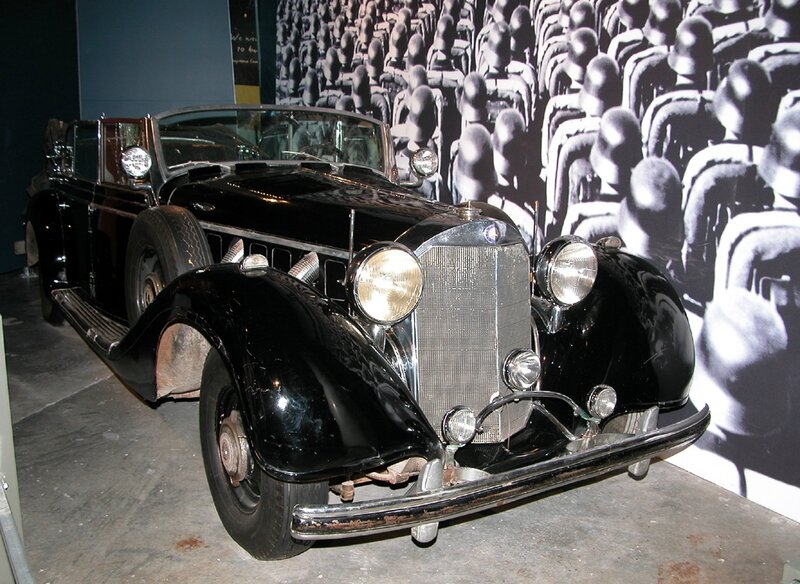
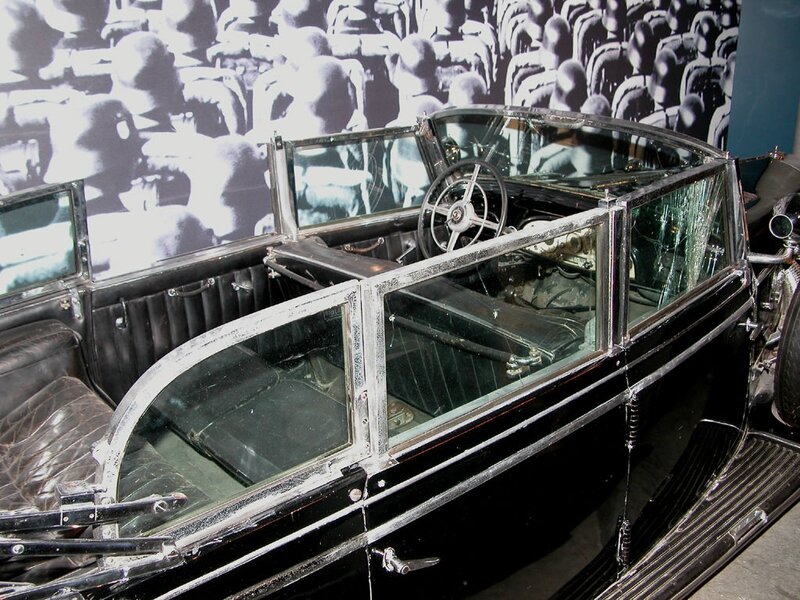
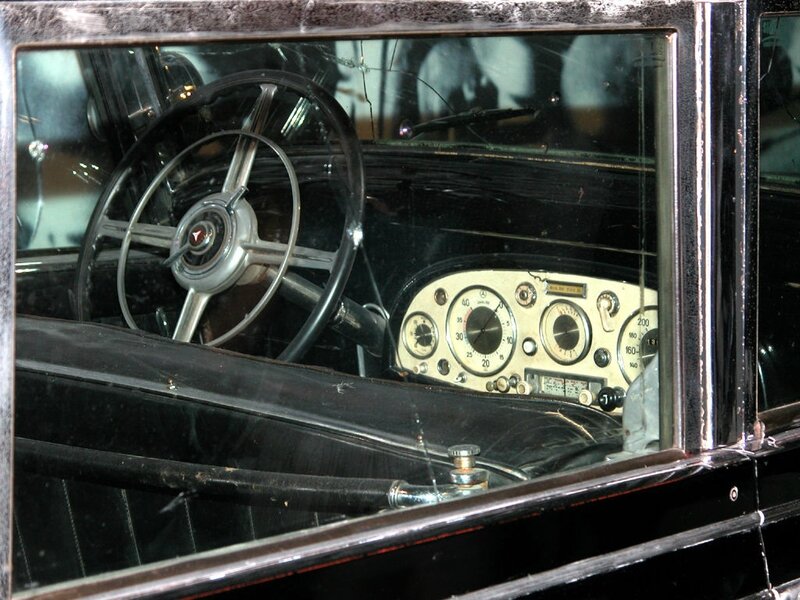

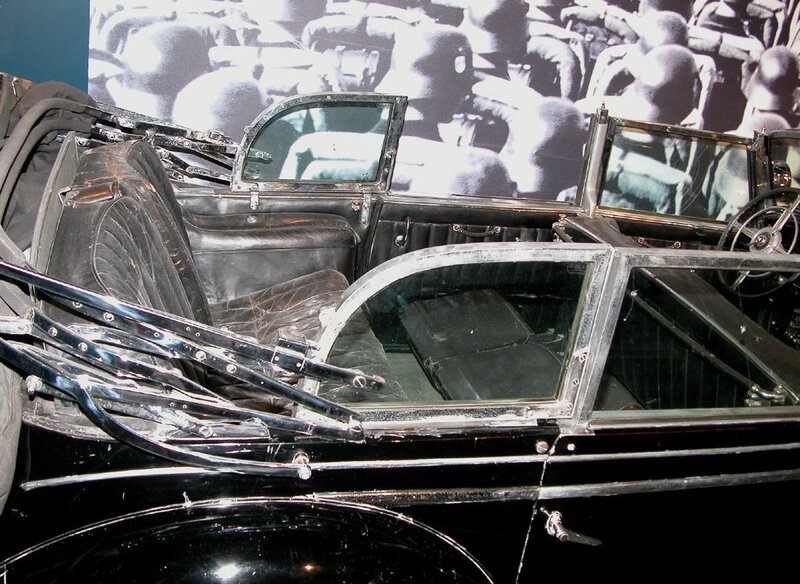
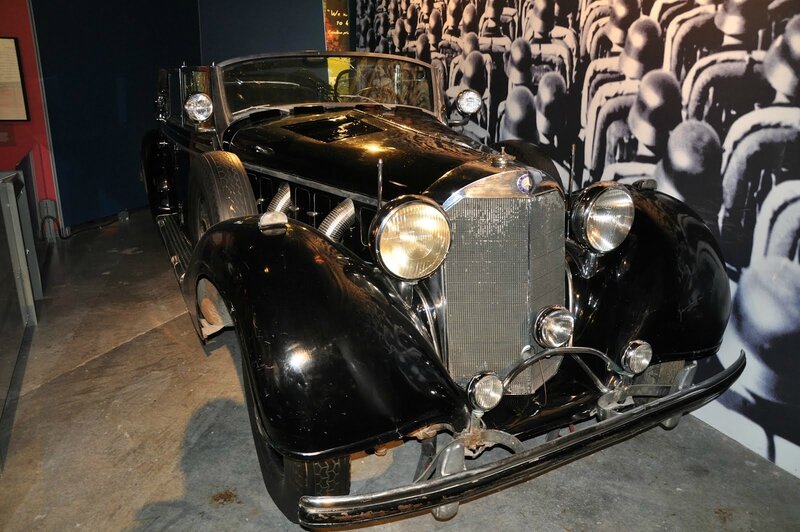

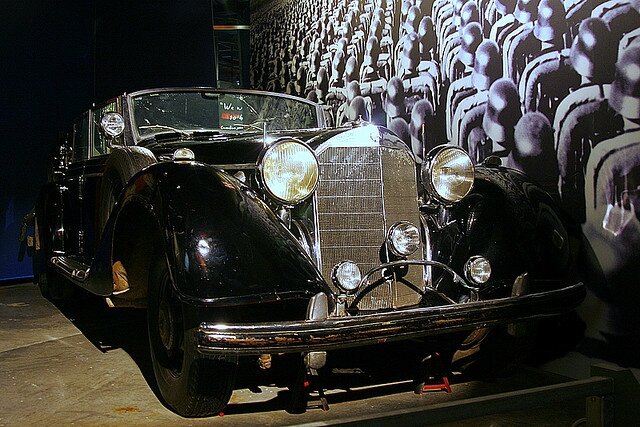


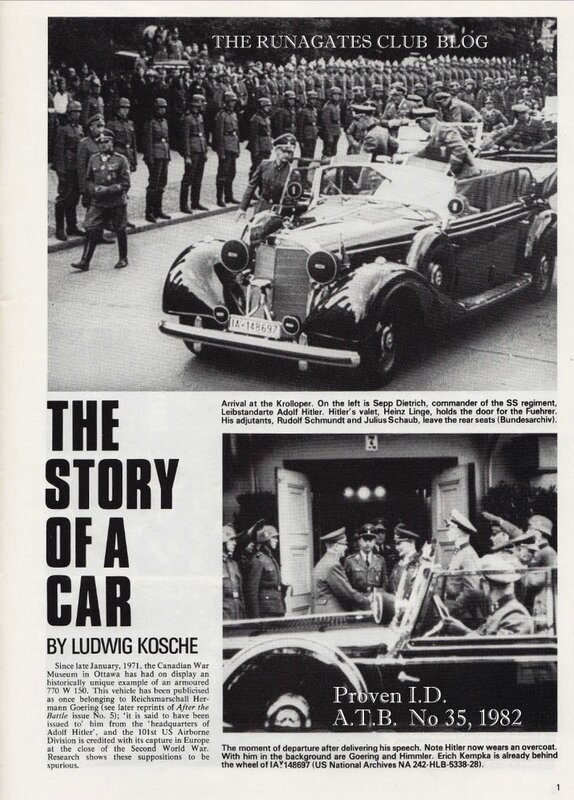
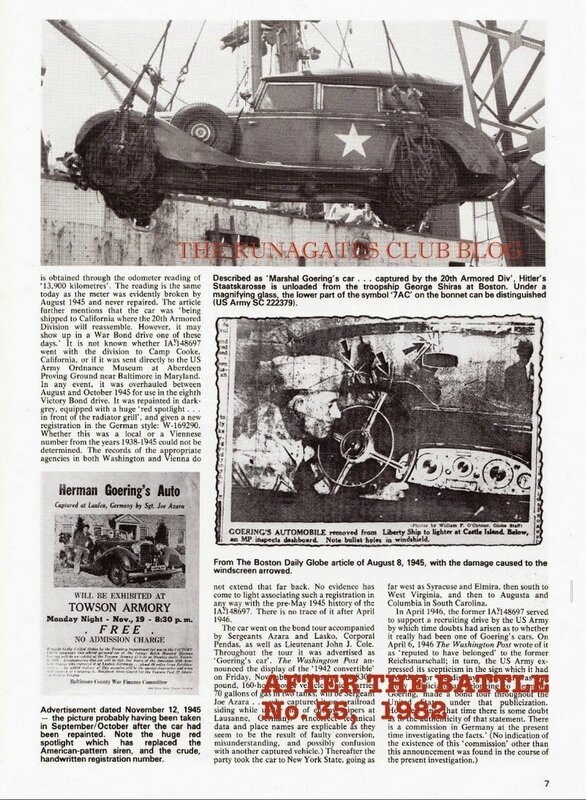

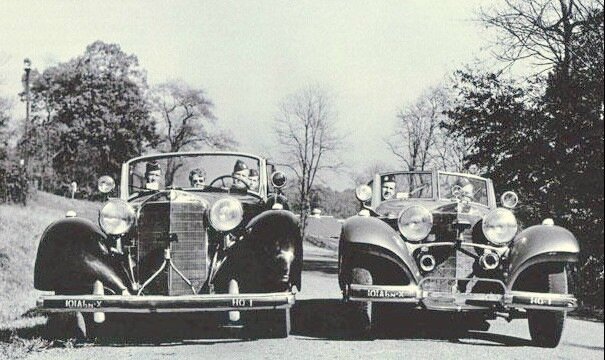
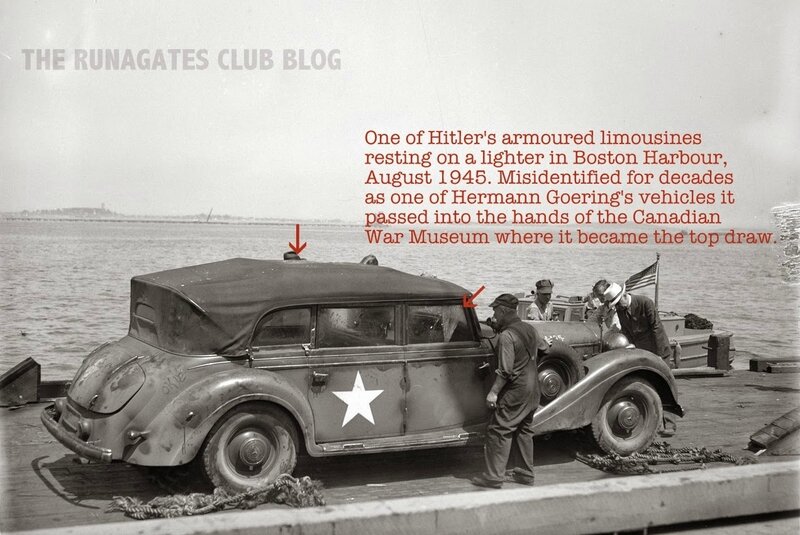
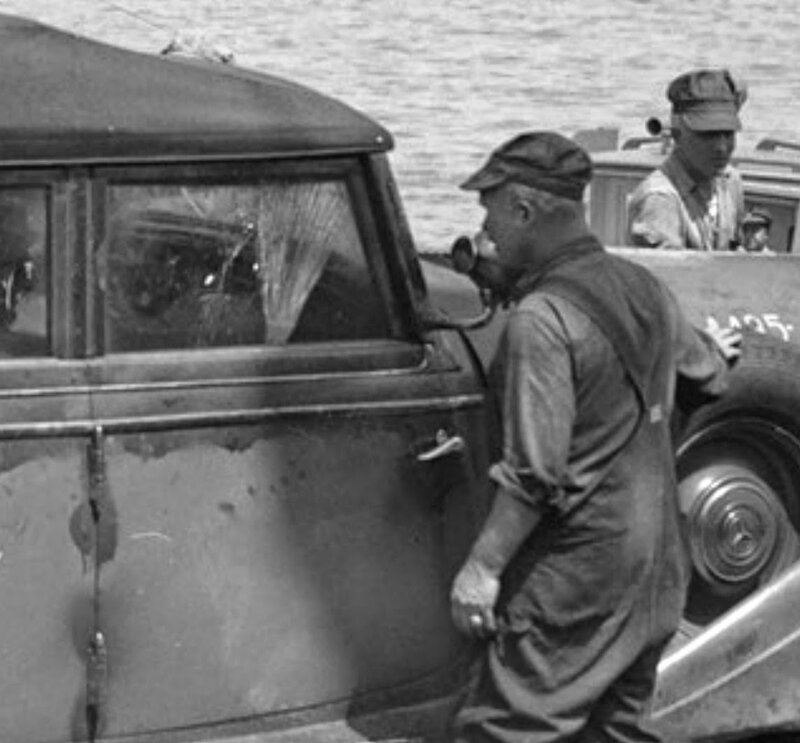
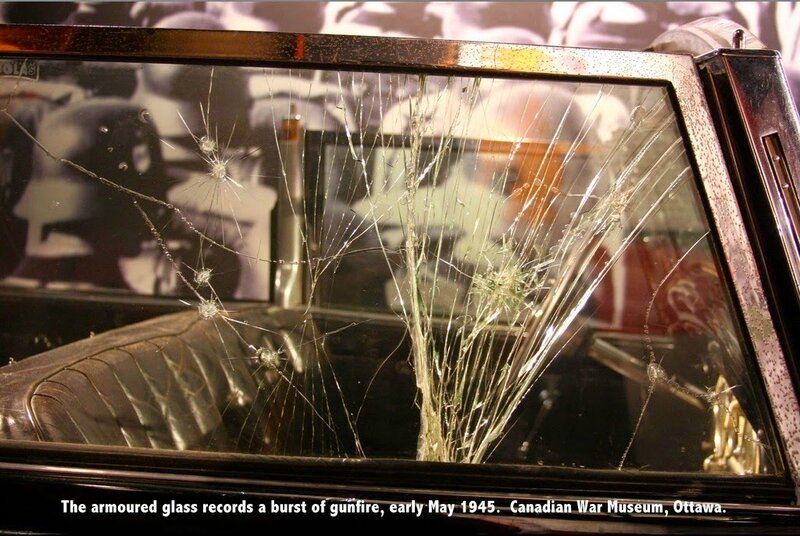


/http%3A%2F%2Fwww.maquetland.com%2Fimages%2Fdemarkation.jpg)
/https%3A%2F%2Fstorage.canalblog.com%2F41%2F09%2F582499%2F126020034_o.jpg)
/https%3A%2F%2Fassets.over-blog.com%2Ft%2Fcedistic%2Fcamera.png)
/https%3A%2F%2Fprofilepics.canalblog.com%2Fprofilepics%2F5%2F4%2F54383.jpg)